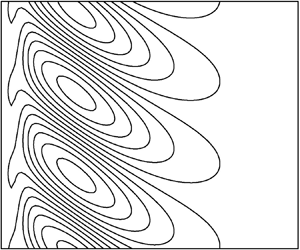Published online by Cambridge University Press: 23 December 2020

When body of fluid with a salinity gradient is heated from an isolated vertical wall instabilities can form. These have been observed in many experiments. The evolving temperature boundary layer causes the fluid to rise and generates horizontal salinity gradients and vertical shear. These background temperature and salinity gradients and the shear can all drive (or inhibit) the instabilities. The time-dependent nature of the background gradients has previously restricted linear stability analysis to some limits where a quasi-static assumption could be made. However, in many of the experiments this assumption is not valid. We investigate the instabilities over the full range of salinity gradients and applied heating, from what is essentially the thermal problem to the strong salinity gradient limit, with two different heating rates. The approach taken is to find the optimal evolution of a quadratic energy-like measure of the amplitude of the instabilities as the background state evolves. This involves a matrix optimization problem. The choice of quadratic measure is not predetermined, but selected to minimize this optimal growth. This approach has been developed previously for the purely thermal case of heating from isolated horizontal and vertical boundaries, and to the double-diffusive problem of heating a salinity gradient from a horizontal lower boundary. We show that there are three regimes of instability when a salinity gradient is heated from a sidewall. There are the small and large Prandtl number regimes observed previously in the purely thermal problem. As the salinity gradient increases the shear-driven small Prandtl number mode is suppressed and only the large Prandtl number mode is observed. For larger salinity gradients a double-diffusive mode of instability appears, which initially has an order-one aspect ratio. As the salinity gradient further increases it evolves into the thin almost horizontal intrusions of the quasi-static analysis. These findings are in line with experimental observations.